youngwithaclass1:
Anyway my question is that i currently don’t have a adr, and at palletways your not allowed out your cab to watch whats being loaded so every now and again i get 4-5 pallets of oil drums on my trailer.
what i’m worried about is that cos i don;t have an adr i’m not certifcated to carry such goods, just wondering weather anyone could shed light on this?
Hi youngwithaclass1, There is a very simple answer to this, but first I have to ask what’s written on your paperwork, and whether there are any labels on the drums??
If you read my explanation below, I hope you’ll discover why I asked you the two questions above. 
Transport document
Dangerous goods must be correctly noted on your Transport Document.
All dangerous goods are allocated a “UN Number” consisting of four digits with the letters “UN” written first.
The “UN” number tells us that it’s something dangerous, and the fact that the letters “UN” MUST be written first saves us from getting a four-digit number confused with a phone number for a hot date. 

UN numbers are the same for the same ‘stuff’ by all modes of carriage all around the world.
Next, the Proper Shipping Name (PSN) must appear, followed by the “Class” number, followed by the Packing Group (PG) if one is allocated. For this explanation, it’ll look something like this:
UN number, PSN, Class and PG
Those four pieces of information must be written in that order, then that gets around the problems caused by foreign languages, because the system is standardised worldwide.
Just as an example, let’s imagine that we need to carry some petrol in drums.
The paperwork must describe it accurately, like this:
UN 1203 PETROL, 3, PGII
(The law allows the letters “PG” to be left out, cos they make no difference. That’s another reason for the use of ROMAN numerals.  )
)
I’ve covered the UN number and PSN, so now we need to understand the “Class” number. There are 9 classes of dangerous goods, but they aren’t a league table of danger, they just tell us what the type of danger is, and this can be discovered by looking at the symbol in the top half of the diamond. Eg. Flammability, Poisoning or Corrosivity. Again, this gets around the language barrier, so the system is understandable in any country and in any language. This is achieved by the correct use of the appropriate colours, numbers and danger signs. A label in a foreign language, or with no writing on it is perfectly legal, because if the colour, number and danger sign are correct, the text isn’t actually needed.
Here are the 9 danger Classes:
UN Class 1 :arrow_right: ..... UN Class 2 :arrow_right: 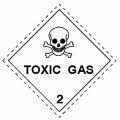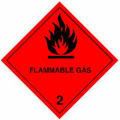 ..... UN Class 3 :arrow_right:  ..... UN Class 4 :arrow_right: 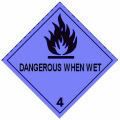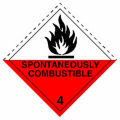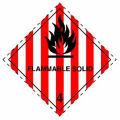 ..... UN Class 5 :arrow_right: 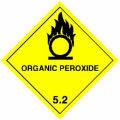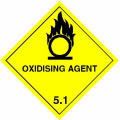 ...[NEW 5.2 LABEL :arrow_right: ]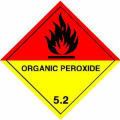 .... UN Class 6 :arrow_right: 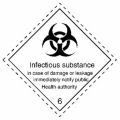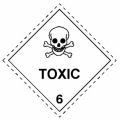 ..... UN Class 7 :arrow_right:  ..... UN Class 8 :arrow_right:  ..... UN Class 9 :arrow_right: 
Next, we need to understand the meaning of Packing Groups (PGs)
A packing group is the way that we can discover how dangerous something is, and it also tells the people who fill packages what standard of packaging to use. There are three PGs. The PGs are ALWAYS indicated by using ROMAN NUMERALS, which neatly avoids any possible confusion with the class number. 
PGI = High Danger,
PGII = Medium Danger
PGIII = Low Danger
Up to now, what I’ve written is legally required and is valid for the worldwide transport of dangerous goods by all modes of carriage. This comes in books published by the United Nations (UN.)
The regulatory bodies for the various modes of carriage then take these ‘basics’ and develop them into Regulations specific to the mode of carriage.
ADR is valid for international transport of dangerous goods in road vehicles in the whole of the EU, plus a number of other countries on the European mainland including Russia, Kazakhstan, Norway and Switzerland.
Ships, aeroplanes and trains have their own sets of dangerous goods Regs called IMDG, IATA and RID respectively.
For ADR purposes, once the dangerous goods have been correctly identified, we should realise that ADR gives ‘freebies’ when the ‘stuff’ comes in packages. The amount of the ‘freebies’ depends on how dangerous the goods are. If something is VERY dangerous, it will be regulated either straight away, or once there is only a small amount on board the vehicle. If the goods are only ‘a bit’ dangerous, then they’re allowed to be carried in larger amounts before the Regs need to be obeyed. That’s the point at which the ADR licence and the displaying of the orange boards on the vehicle is required. It’s only really ADR that adopts this ‘layered’ approach. The other sets of Regs don’t normally have the concept of ‘freebies’ so their Regs begin to bite quite quickly and will affect quite small quantities of dangerous goods, but do not affect truck drivers.
 It’s also partly one of the reasons that you don’t see orange boards on ships or aeroplanes.
It’s also partly one of the reasons that you don’t see orange boards on ships or aeroplanes. 

In the above example of petrol in drums, the ADR ‘freebie’ is 333 ltrs, because petrol is Class 3, PGII. Up to that amount, you can carry it without needing an ADR licence or displaying orange boards. Now let’s imagine that we’re going to carry Diesel Fuel in drums.
Correctly written, it looks like this:
UN 1202 DIESEL FUEL, 3, PGIII
We all know that diesel isn’t as dangerous (flammable) as petrol, so that’s why the PG number is different.
In the case of diesel fuel, the ADR ‘freebie’ is 1,000 ltrs, due to the fact that there’s less danger.
Both petrol and diesel have the same danger (flammability) so either one of them would need the appropriate class label on the drum(s) ie a red label with a figure three on it and a flame symbol in the top half like this:
 From this, you can tell what the danger is, but not how dangerous it is.
From this, you can tell what the danger is, but not how dangerous it is. 
If there are any markings on the drum other than the diamond type above, then the ‘stuff’ isn’t dangerous, and you needn’t worry about it.
Other markings might be Eg. an orange square with a cross on it or an orange square with a dead fish lying next to a tree. These have NO relevance to ADR, or to taking the stuff on the roads. They are simply a different set of Regs that apply to those who actually use the ‘hazardous’ stuff in their work. The diamond and the UN number on the drum(s) is the clue as to whether the ‘stuff’ inside counts as ‘dangerous.’
“Hazardous” and “dangerous” have different legal definitions. 
All a driver ever needs to learn is the class system ie. colour, number and danger sign and that this is found on packages, + the idea that the PG represents the degree of danger and that this is found on the transport document.
The rest of everything else I’ve written is either the responsibility of the consignor (= sender,) or the carrier ( = vehicle owner.)
The law defines a consignor as the sender of the dangerous goods, even if they provide the service without actually owning the dangerous goods, so the pallet hub IS the consignor, whether they realise it or not, and whether they like it or not. 
As for you not being certificated to carry dangerous goods, I can tell you that you can carry a very wide range of dangerous goods perfectly legally WITHOUT being certificated.
The ‘freebies’ I mentioned above depend on a combination of several factors including, the size/type of package(s,) the degree of danger and the total amount loaded on the vehicle.
We should now understand that there are approx 3,200 dangerous goods listed in ADR, and that the system I’ve described is potentially different for each one of them, because some dangerous goods have certain other exemptions too.
It is the vehicle owner’s legal responsibility to understand this and in most cases to appoint a qualified Dangerous Goods Safety Advisor (DGSA,) whose legal responsibilities are defined in ADR.
You can find other questions, and my answers, on ADR topics here: ADR “Sticky” in the H&S forum
ADR “Sticky” in the H&S forum
For those thinking of doing an ADR course, reading the above (carefully) will be very helpful in passing the exams. 


I hope this helps you to rest easy in your bed. 
 funkyfella has an excellent point, because ADR forbids smoking in a vehicle, or in the vicinity of a vehicle, whilst loading or unloading, even if the goods aren’t flammable.
funkyfella has an excellent point, because ADR forbids smoking in a vehicle, or in the vicinity of a vehicle, whilst loading or unloading, even if the goods aren’t flammable.


 From this, you can tell what the danger is, but not how dangerous it is.
From this, you can tell what the danger is, but not how dangerous it is.  funkyfella has an excellent point, because ADR forbids smoking in a vehicle, or in the vicinity of a vehicle, whilst loading or unloading, even if the goods aren’t flammable.
funkyfella has an excellent point, because ADR forbids smoking in a vehicle, or in the vicinity of a vehicle, whilst loading or unloading, even if the goods aren’t flammable.